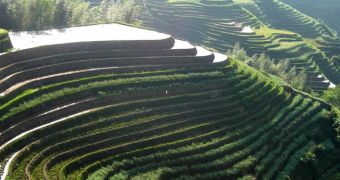During 4 million years of evolution, people just gathered, hunted and fished what nature offered, living just like another intelligent mammal.
But about 12,000 years ago, with the Neolithic ("new stone") era, people started to be producers, creating voluntarily their subsistence means and breaking their dependence on nature's offer. In time, gathering, hunting and fishing lost importance in front of animal husbandry and plant cultivation.
There were probably intermediary stages of crop gatherers: these tribes did not raise animals or cultivate the land, but gathered systematically the products of specific wild plants, which grew abundantly and formed the base of their alimentation. These people made food deposits and even built barns.
The most primitive form of land cultivation was with the planter, derived from the digging stick of the gatherer. It is a pointed stick, sometimes weighed with a stone disk. A more advanced form was the soil overturn with the hoe.
Disks found at Ierichon (on Jordan valley) are a proof for planter use, together with grinders, pestles and sickles.
The existence of many wild cereals (barley, wheat, millet), pod vegetables (tick bean, pea, lentil) was an ideal condition in the Middle East that made people 11,000-10,000 years ago to start collecting these wild comestible crops in what is now Iraq. At the same time, wild sheep were on the way of being domesticated. 9,000 years ago, wheat and barley cultivation, and also sheep and goat husbandry were booming in the area.
In Thailand were found cereal grains in 11,000 years old pots while in Mexico was found corn pollen 5,600 years old but also pumpkin and bean remains dated to 8,500 years ago.
Plant cultivativation appeared concomitantly in many spots in the world. In the Middle East and the Mediterranean area, the dry climate imposed an intensive agriculture, based on draining, irrigations, terracement, and the arrangement of artificial basins based on collective work.
The great progress was made by the invention of the plow. As the first plows were made of wood, it's hard to establish their origin. Written documents show they were used 5,000 years ago in Mesopotamia, from where they spread. 4,000 years ago the plow was found in Egypt, 3,400 years ago in China and 3,000 years ago in northern Europe.
In Europe plows made of deer antlers have been discovered. Still, the plow was not known in Americas, Oceania and in Black Africa is known just in some areas.
The invention of the animal pulled plow further revolutionizes agriculture. This also meant the development of the yoke and the bridle. A Cyprus miniature makes us suppose that the common practice was the teaming of a pair of oxen to each plow. The iron share appeared only on the second iron age, about 2,500 years ago.
In forested areas, people employed the itinerant agriculture, still practiced in some tropical areas by primitive tribes. The fields were made by chopping the big trees and burning the rest of the vegetation.
When the soil was exhausted, the plot was changed and another forest area was chosen for cultivation. People also found natural or artificial methods of fertilizing the soil. The periodic cultivation of pod vegetables enriched the soil on nitrogen.
Cattle manure use as fertilizer is known for 5,000 years. In animal husbandry, an intermediary stage could have been represented first by the following herds of wild animals by stone age people. By supervising their movements, people started to know their behavior and started to fence their routes and tame them.
Animals started to be domesticated 11,000 years ago (of course, the dog could have been domesticated earlier). 5,600 years ago the horse was domesticated on the north of the Black Sea and Caspian Sea and for long it was employed just for milk and meat production; much later was used for transport, by about 3,500 years ago.
Some ancient civilizations just passed to plant cultivation (like in Americas), others just to animal husbandry (Central Asia) and others to a mixed production (Middle East).
In this situation, the products change was necessary between different producer categories.

 14 DAY TRIAL //
14 DAY TRIAL //